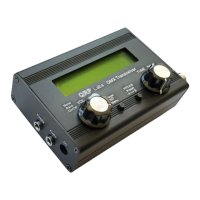IMPORTANT!
QMX can be built for 9V or 12V operation! You need to decide NOW!
A 9V QMX produces 5 W power output from a supply voltage of 9V or a little over. At 12V, a QMX
built for 9V could be producing 8 W power output which is likely to cause over-heating and
perhaps failure of the BS170 final transistors. Do not power a QMX with a higher voltage than you
built it for.
Operation of QMX at more than 5W power output is NOT RECOMMENDED.
If you wish to operate using a 12 V supply, you may use a two turn secondary winding on the
output transformer T1, so a 3:2 ratio instead of the 3:3 turns ratio documented in this manual.
Remember this when you come to the assembly step for preparing and installing the output
transformer T1. The “primary” is still 3 turns, with a tap half way at 1.5 turns. The secondary (no
tap) will now be only two turns.
The chart below shows the measured power output vs supply voltage for the standard 3:3 winding
(Red line); at 12 V supply the output power of around 8 W is too high and likely to cause over-
heating or failure of the power amplifier transistors. If you wish to use a supply of 12 - 13 V the 3:2
winding style is more suitable and will produce 4 – 5 W output for 12 – 13 V supply. The graph
shows 40m but other bands are very similar.
Operation at more than 12V will reduce the protection safety margin available in the event of very
long key-downs, hot environment, antenna mismatch, cable faults etc. I don’t recommend more
than 12V. It isn’t worth pushing more just for a fraction of a dB. It is acceptable to use diodes in
series on the power line, each one will drop the voltage 0.6V or so. Beware that a 12V nominal
battery will potentially be several volts higher when fully charged.
QMX assembly Rev 1.00e 4

